

|
 |

- All wingless
- 0.2 - 10mm long
- Entognathous mouthparts
- Colours range from white to black, includes green, yellow, striped and mottled species
- Springing organ (furcula) is held beneath the body
- Three pregenital appendages on the ventral side
- 1,500 species, over 300 in Britain
- World-wide, from Antarctica to subarctic
- Habitats: moist environments including leaf litter, ant and termite mounds, inter-tidal zone, fresh water, from sea-level to 7000m
- Feed on decaying vegetation, algae, fungi, lichen, decomposing animal matter, spores and pollen
|
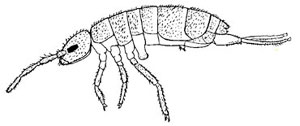
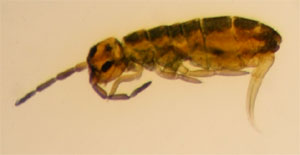 |
Form dense aggregations in moist habitats in response to aggregation pheromones. Clusters on snowfields appear red.
- All wingless
- Maximum 2mm long
- Entognathous mouthparts
- Have no eyes or antennae
- Head is cone-shaped, pyriform or egg-shaped
- Body is elongate, delicate and tapers to the rear
- Jointed legs on the first three segments
- 200 species, 20 in Britain
- World-wide
- Habitats: moist, e.g. soil and leaf litter
- Possibly fungivorous
|
 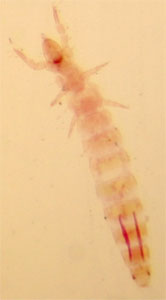 |
Protura walk on their two hind pairs of legs and use their front pair as antennae
The cuticle of proturans is very unusual, with many pits and projections, which may be sensory.
- All wingless
- 2 - 50mm long
- Entognathous mouthparts
- Generally white
- 2 posterior cerci
- Elongate, 10-segmented abdomen
- Clearly separated thoracic segments
- 800 species, 11 in Britain
- World-wide, mainly subtropical and tropical
- Habitats: damp, e.g. leaf litter, under stones, in soil
- Suborder Campodeida herbivorous, other suborders prey on smaller arthropods
|
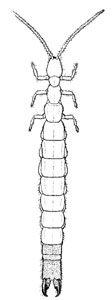 |
Some diplurans guard their young. Less aggressive species from small, unstructured aggregations and also occur in association with ants and termites.
Larvae of other orders are often described as "campodeiform", i.e. looking like the dipluran Suborder Campodeida.
- All wingless
- 6 - 18mm long
- Biting mouthparts
- Eyes reduced or absent
- Shuttle-shaped
- Metallic sheen of grey, brown or white scales
- 330 species, at least 9 in Britain
- World-wide
- Habitats: among leaves, in wood, under stones, on seashore etc. as well as indoors
- Mainly scavengers
|
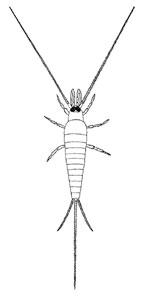 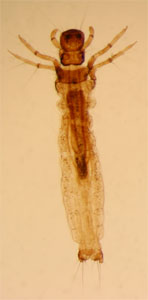 |
Considered to be a living fossil of the insect world
|















